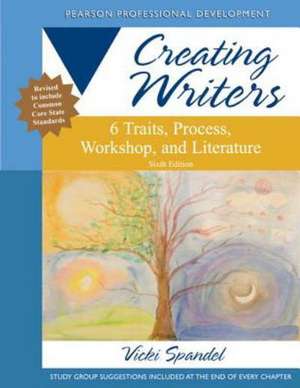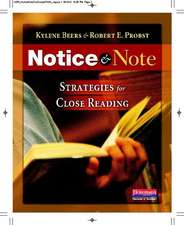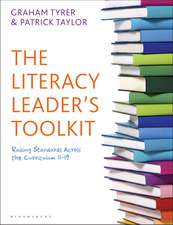Creating Writers: 6 Traits, Process, Workshop, and Literature: Pearson Professional Development
Autor Vicki Spandelen Limba Engleză Paperback – 17 oct 2012
Preț: 575.69 lei
Preț vechi: 646.84 lei
-11% Nou
Puncte Express: 864
Preț estimativ în valută:
110.17€ • 114.60$ • 90.95£
110.17€ • 114.60$ • 90.95£
Carte disponibilă
Livrare economică 24 martie-07 aprilie
Preluare comenzi: 021 569.72.76
Specificații
ISBN-13: 9780132944106
ISBN-10: 0132944103
Pagini: 460
Dimensiuni: 215 x 275 x 23 mm
Greutate: 1.08 kg
Ediția:Revised
Editura: Pearson
Seria Pearson Professional Development
ISBN-10: 0132944103
Pagini: 460
Dimensiuni: 215 x 275 x 23 mm
Greutate: 1.08 kg
Ediția:Revised
Editura: Pearson
Seria Pearson Professional Development
Notă biografică
Vicki Spandel has worked as a language arts teacher, editor, journalist, technical writer, and award winning video producer. Since her work developing the original, internationally recognized 6-Trait Model for writing assessment and instruction, she has served as scoring director for more than 75 state, county, and district writing assessments. Vicki is a frequent visitor in writing classrooms, providing coaching on writing, revision, and editing. Her books include Creating Writers Through 6-Trait Writing and Creating Young Writers (Allyn & Bacon); The 9 Rights of Every Writer (Heinemann); and The Write Traits series (Great Source Education Group).
Cuprins
Chapter 1: Getting Acquainted with the Six Traits Enter the traits ... Who invented the six traits? A Quick Overview Responding to Student Writing What Teachers Value in Writing Warming Up with the One-Pager 10 Tips for Scoring Well Connecting the 6 Traits to Research-Based Strategies Connecting the 6 Traits to the Common Core Standards for Writing Some Closing Thoughts Study Group: Interactive Questions and Activities Chapter 2: Setting the Stage with Writing Process and Writing Workshop Setting the Stage with Writing Process Experience: The Well We Draw From Rehearsing and Prewriting: Giving Shape to the Ideas We've Chosen Drafting: Going from Beginning to End Sharing with an Audience Revising: Letting the Traits Shine Editing: Making the Reader Feel "At Home" in Your Text Publishing: Honoring and Preserving Writing Assessing: for Students, the First Step in Revising What about Genre? Setting the Stage with Writing Workshop What happens in writing workshop? Following a Routine On Day 1 Are some writers too young? Ensuring Safety Allotting Time Two Myths In Judy's Third Grade Writing Workshop The Atmosphere Room Arrangement Workshop Schedule Conferences Sharing In Billie's Seventh Grade Writing Workshop Trait Aerobics The Magic of Modeling Backwards Planning In Barbara's Middle School Writing Workshop Choosing Topics Modeling Assessing Writing as a Class Pick Your Corner! Reviewing Individual Students' Work In Andrea's Second-Language Classroom Key Words Learning Kinesthetically Everyone Writes Using Technology In Jim's High School Writing Class Focus, Direction-and Language Comparing Responses Built-in Flexibility Study Group: Interactive Questions and Activities Chapter 3: Making Meaning with IDEAS How do I begin? Student Writing Guide for Ideas (Figure 3.2) Teacher Writing Guide for Ideas (Figure 3.3) Ideas: Meaning & Message A Definition Trait Shortie for Ideas (Figure 3.4) Warming Up with Literature Just a Taste (small samples) Using a Whole Book Other Books Wonderful for Teaching Ideas Assessing Writing Samples for Ideas Paper 1: Making Decisions (Expository, Grade 8) Paper 2: The Best Gift (Memoir, Grade 6) Paper 3: The Baseball (Narrative, Grade 5) Paper 4: Metamorphosis (Narrative, Grade 9) Paper 5: Going Veggie (Persuasive, Grade 4) Paper 6: Writing Is Important (Expository, Grade 11) Paper 7: Harder Than You Think (Expository, Grade 10) Paper 8: Why Writing Matters (Expository, Grade 6) Lessons and Strategies for Teaching IDEAS Some Quick Trait Logistics 52 How long should I spend teaching a single trait? Is it important to teach the traits in a particular order? Should I teach every feature of every trait? What happens once I finish teaching all the traits? Study Group: Interactive Questions and Activities Chapter 4: Showcasing the Message with ORGANIZATION Organization: Structure and Design A Definition Student Writing Guide for Organization (Figure 4.1) Teacher Writing Guide for Organization (Figure 4.2) Trait Shortie for Organization (Figure 4.3) Warming Up with Literature Just a taste ... Using a whole book Other Books with Interesting Organizational Structure Assessing Writing Samples for Organization Paper 1: Some Cartoons Are Violent! (Persuasive, Grade 3) Paper 2: A Great Book (Literary Analysis, Grade 8) Paper 3: Movies and Books: A Comparison (Expository, Grade 8) Paper 4: Are Films Too Violent? (Persuasive, Grade 5) Paper 5: How to Be a Good Driver (Expository, Grade 12) Paper 6: Computing Batting Averages (Expository, Grade 6) Paper 7: Cats or Dogs (Persuasive, Grade 6) Paper 8: Sand Dollar (Narrative, Grade 8) Lessons and Strategies for Teaching ORGANIZATION Study Group: Interactive Questions and Activities Chapter 5: Making the Heart Beat with VOICE Voice: The Heartbeat A Definition What Is Voice? (Figure 5.1) Student Writing Guide for Voice (Figure 5.2) Teacher Writing Guide for Voice (Figure 5.3) Trait Shortie for Voice (Figure 5.4) Warming Up with Literature Just a taste ... Using a whole book Other Books with Striking (Read-aloud) Voice Assessing Writing Samples for Voice Paper 1: Why You Need a Job (Persuasive, Grade 9) Paper 2: Zeena and the Marshmellows (Persuasive, Grade 5) Paper 3: A Sunflower Seed (Expository/Reflective, Grade 5) Paper 4: Fishing (Narrative/Expository, Grade 11) Paper 5: You Whant to Be My Friend? (Expository, Grade 3) Paper 6: Unscripted Television: Enjoy It While You Can (Persuasive, Middle School) Paper 7: The Perfect Tree (Narrative/Memoir, Grade 7) Lessons and Strategies for Teaching VOICE Study Group: Interactive Questions and Activities Chapter 6: Enhancing Meaning and Voice with WORD CHOICE Word Choice: Phrasing and Terminology A Definition Student Writing Guide for Word Choice (Figure 6.1) Teacher Writing Guide for Word Choice (Figure 6.2) Trait Shortie for Word Choice (Figure 6.3) Warming Up with Literature Just a taste ... Using a whole book Other Books Filled with Words and Expressions You'll Remember Assessing Writing Samples for Word Choice Paper 1: Chad (Descriptive, Grade 3) Paper 2: Pets Are Forever: An Investigative Report (Expository, Grade 8) Paper 3: Fishing Lessons (Memoir, Grade 7) Paper 4: Elephants (Expository, Grade 5) Paper 5: A Strange Visitor (Narrative/Imaginative, Grade 5) Paper 6: The Pirate Ship (Descriptive, Grade 5) Paper 7: Kill Measure 34-Now! (Persuasive, Grade 8) Lessons and Strategies for Teaching Word Choice Study Group: Interactive Questions and Activities Chapter 7: Enhancing Meaning and Voice with SENTENCE FLUENCY Sentence Fluency: Rhythm & Readability A Definition Student Writing Guide for Sentence Fluency (Figure 7.1) Teacher Writing Guide for Sentence Fluency (Figure 7.2) Trait Shortie for Sentence Fluency (Figure 7.3) Warming Up with Literature Just a taste ... Using a whole book Other Books Filled with Collectible Sentences Assessing Writing Samples for Sentence Fluency Paper 1: The Closet Monster (Imaginative Fantasy, Grade 3) Paper 2: The Big Road (Narrative, Grade 7) Paper 3: Xeriscaping (Persuasive, Grade 5) Paper 4: The Ritual of Rocks and Sticks (Imaginative/Narrative, Grade 6) Paper 5: Why I Write (Expository, Grade 7) Paper 6: A Rescue (Narrative, Grade 4) Paper 7: Marco Polo (Imaginative Journal (Grade 4) Paper 8: Call Me When You Get There (Expository, Grade 8) Lessons and Strategies for Teaching Sentence Fluency Study Group: Interactive Questions and Activities Chapter 8: Preparing to Publish with CONVENTIONS & PRESENTATION Step 1: Editing (Textual Conventions) Conventions? Isn't that the easiesttrait to assess? Step 2: Packaging (Visual Conventions/Presentation) How important is presentation in the overall score? Going Beyond Print Conventions & Presentation: Readiness for Publication A Definition Student Writing Guide for Conventions & Presentation (Figure 8.2) Teacher Writing Guide for Conventions & Presentation (Figure 8.3) Trait Shortie for Conventions & Presentation (Figure 8.4) Warming Up with Literature Books with Clever Conventions Books with Arresting Presentation Resource Books for You, Your Students or Both Assessing Writing Samples for Conventions 6 Keys to Scoring Conventions Well Paper 1: Haircut from Hell (Narrative/Imaginative, Grade 7) Paper 2: Japan (Expository, Grade 3) Paper 3: The Joke (Memoir, Grade 7) Paper 4: Computer Blues (Narrative, Grade 12) Considering Presentation Poetry: "Rain and Ivy" A Published Piece: Coco Writes Original Art: Thandi An Original Picture Book: A Great Journey A Collage of Covers: Creating Writers Lessons and Strategies for Teaching Conventions A Message for Parents and Guardians Strategies for Introducing and Teaching Presentation Expanding Presentation through Technology Study Group: Interactive Questions and Activities Chapter 9: Going INFORMATIONAL Trait by Trait: A Quick Review Informational Writing A Definition One-Pager Informational Writing Guide for Teachers (9.1) Informational Writing Guides for Students (9.2 through 9.7) Assessing Informational Writing Paper 1: Black Widows (Informational, Grade 3) Paper 2: Gorillas (Informational (Grade 4) Paper 3: Our History: Strange But True (Informational, Grade 5) Paper 4: Mini Vampires (Informational, Grade 5) Paper 5: Stars (Informational, Grade 5) Paper 6: The Middle Ages (Informational, Grade 7) Paper 7: Life in the Middle Ages (Informational, Grade 7) Paper 8: Humboldt Penguins (Informational, Grade 9) Paper 9: Method Acting (Informational, Grade 12) 9 Strategies for Helping Students Create Powerful Informational Writing Informational Favorites (A Booklist) Persuasive Writing and Thoughts About "Trait Eight" 4 Simple Steps to Your Own Persuasive Checklist Paper 11: Driving Tests Should Be Harder (Persuasive, Grade 7) Paper 12: Smoking Stinks! (Persuasive, Grade 5) Study Group: Interactive Questions and Activities Chapter 10: Exploring the World of BEGINNING WRITERS Focusing on Strengths Bat and Spider (Age 4) Mike's Note (Age 5) Taking a Close Look at Primary Writing What to Look for in Primary Writing (Figure 10.1) Early Guides to Traits (Figure 10.2) Sample Papers "Clouds" by Nicole (Grade 1) "Sam Is My Friend" by Kean (Grade 1) "My Favorite Brother Is Nick" by Lincoln (Grade 1) "I Like My Library" by Nicholas (Grade 1) "CatDog Shopping" by Jocelyn (Grade 1) Mason's First Book (K) "Old" by Megan (Grade 3) "Dear Tooth Fairy" by Leah (Grade 2) "Jamey the Cat" by Veronica (Grade 2) "Pyramid" by Brad (Grade 2) Three Short Pieces by Andrew (K) "Love" by Kaden (Grade 1) "My Friend" by Jane (Grade 1) "Spiderman" by Wyatt (Grade 1) "My Winter Vacation" by Connor (Grade 2) "Guess Why I Like School" by Hollie (Grade 1) Using the 6 Traits to Teach Primary Writing Primary Books for Teaching Ideas Primary Books for Teaching Organization Primary Books for Teaching Voice Primary Books for Teaching Word Choice Primary Books for Teaching Sentence Fluency Primary Books for Teaching Conventions & Presentation Assessing Young Writers Assessment Step 1: Looking Carefully at Student Writing Assessment Step 2: Observing Young Writers Carefully Assessment Step 3: Asking Children to Talk about Their Process Assessment Step 4: Keeping Portfolios Assessment Step 5: Using Age-Appropriate Tools for Assessment Avoid Scales Intended for Older Writers Early Guides to Traits (Assessing Examples) Primary Continuums (Figure 10.17) Closing Thoughts Study Group: Interactive Questions and Activities Chapter 11: COMMUNICATING about Students' Writing Comments But ... we meant well! Encouraging Comments + Modeling = Path to Success Offer Suggestions through Modeling Comments plus Rubrics Quick Practice "Waters of Death" (Figure 11.2) "The Bathroom" (Figure 11.3) Conferences A good conference begins with listening ... is also short ... puts the writer in control ... is flexible Sharing: Connecting with an Audience 10 Things You Can Do 1. Help students develop good listening skills 2. Think about logistics. 3. Define roles clearly 4. Model what not to do. 5. Write notes. 6. Encourage responders to "begin with I." 7. Participate. 8. Don't apologize-and don't over-react. 9. Make it real-by sharing what you picture, how you feel. 10. Keep it snappy. Debriefing Communicating with Parents or Guardians Comments on Student Writing "Waters of Death" (Figure 11.2) "The Bathroom" (Figure 11.3) Study Group: Interactive Questions and Activities Chapter 12: ASSESSING Our Students Well Making Large-Scale Writing Assessment All It Can Be Step 1: Have a clear purpose. Step 2: Design an Assessment to match our vision of success. Step 3: Match the assessment approach to the task. Step 4: Design rubrics or writing guides with care. Step 5: Be thoughtful about prompts. Step 6: Abolish forever the dreaded "off-topic" label. Step 7: Become truly skilled assessors. Step 8: Teach on-demand writing as a genre unto itself. Step 9: Minimize bias. Step 10: Consider multiple samples. Step 11: Ensure that assessments are reliable and valid. Step 12: Make writing a priority. Making Classroom Writing Assessment All It Can Be Step 1: Define our personal vision of success. Step 2: Let the writing tell its own story. Step 3: Think process-not just product. Step 4: Assess some pieces deeply-to see what students cando. Step 5: Provide both formative and summative assessment. Step 6: Assess what matters-not what's obvious. Step 7: Teach students to evaluate their own work. Step 8: Make personal comments a major part of any feedback. Step 9: Be flexible about genre and format. Step 10: Encourage students to develop "habits of mind" essential for success. Grading What Grades Mean to Students How and What to Grade Grading as a Control Issue Translating Analytical Scores into Grades Final Thoughts Study Group: Interactive Questions and Activities Looking Forward: Expanding the Vision Appendices Appendix 1 Brief History of the Traits Appendix 2 Teacher Three-Level Writing Guide (Adaptable to 5- or 6-Point) Appendix 3 Student Three-Level Writing Guide (Adaptable to 5- or 6-Point) Appendix 4 Student "Leap the River" Writing Guide in Spanish Appendix 5 Student Checklist in Spanish Appendix 6 Requirements by Genre: Common Core Standards for Writing
Recenzii
The text itself is well-written, and in my opinion Spandel does not waste words. As I read through the book, I found myself hanging on to her every word. - Jane Feber, Retired Language Arts Teacher, Jacksonville, FL Spandel's style is full of voice and verve. Her style is always clear and engaging. Her organization is superb, leading us through the 6 traits in a logical and thought-provoking fashion. She speaks directly to teachers with expertise we find believable. She gives us confidence to improve our craft. This book is frequently helpful to me as a classroom teacher. Writing lessons in our classrooms look different every year, every day. Our lessons depend on the needs of our individual students. I am always looking to CW for new ways to help my kiddos become joyful writers. I so appreciate Spandel's warm and inviting style-she speaks to me. - Judy Mazur, 5th Grade Teacher, Buena Vista Elementary School, Walnut Creek, CA Spandel provides more than just theory or just strategies; rather, she combines both theory and practice within a flexible framework that my candidates can use to approach writing instruction in a structured - but not prescribed - manner. Spandel's approach helps my students see ways to synthesize literature, reading, and writing instruction in a meaningful fashion. - Kristina J. Doubet, Professor, Department of Middle and Secondary Education, James Madison University, Harrisonburg, VA
Textul de pe ultima copertă
" Creating Writers: 6 Traits, Process, Workshop, and Literature, 6/e " Vicki Spandel "This one-of-a-kind book combines the elements of traits, literature, workshop, and process into one seamless presentation focused on creating successful writers. " "" More than any other book on the market today, "Creating Writers: 6 Traits, Process, Workshop, and Literature, " "6/e, " truly puts the six traits of writing in context, showing how they are best taught within writing workshop and as a way of enriching writing process. Written by the pioneer of 6-trait writing, this edition organizes all materials by trait, features new one-page writing guides, and offers an increased emphasis on literature, connecting writing to reading as never before. It also provides a clear link between the six traits and the Common Core Standards for Writing and presents new lessons, engaging classroom activities, suggestions for using technology, and an expanded collection of student writing sure to promote lively discussions. "The text itself is well-written, and in my opinion Spandel does not waste words. As I read through the book, I found myself hanging on to her every word. " - Jane Feber, Retired Language Arts Teacher, Jacksonville, FL "" "This book is frequently helpful to me as a classroom teacher. Writing lessons in our classrooms look different every year, every day. Our lessons depend on the needs of our individual students. I am always looking to CW for new ways to help my kiddos become joyful writers. I so appreciate Spandel s warm and inviting style she speaks to me." - Judy Mazur, 5th Grade Teacher, Buena Vista Elementary School, Walnut Creek, CA "Spandel provides more than just theory or just strategies; rather, she combines both theory and practice within a flexible framework that my candidates can use to approach writing instruction in a structured but not prescribed manner. Spandel s approach helps my students see ways to synthesize literature, reading, and writing instruction in a meaningful fashion." - Kristina J. Doubet, Professor, Department of Middle and Secondary Education, James Madison University, Harrisonburg, VA Vicki Spandel has worked as a language arts teacher, editor, journalist, technical writer, and award winning video producer. Since her work developing the original, internationally recognized 6-Trait Model for writing assessment and instruction, she has served as scoring director for more than 75 state, county, and district writing assessments. Vicki is a frequent visitor in writing classrooms, providing coaching on writing, revision, and editing. Her books include "Creating Writers Through 6-Trait Writing "and "Creating Young Writers "(Allyn & Bacon); "The 9 Rights of Every Writer" (Heinemann); and "The Write Traits" series (Great Source Education Group). "









